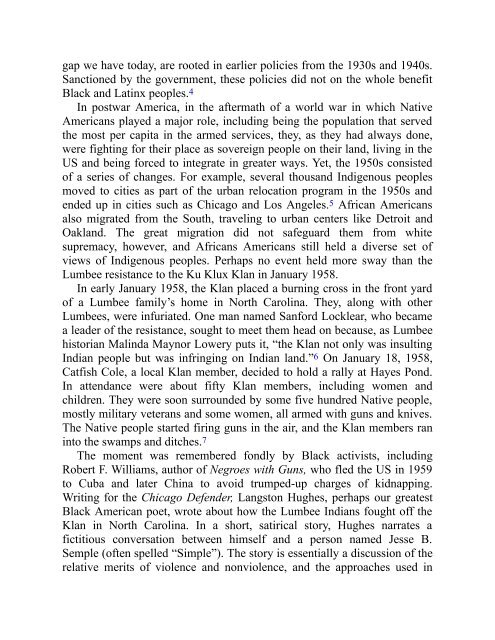You also want an ePaper? Increase the reach of your titles
YUMPU automatically turns print PDFs into web optimized ePapers that Google loves.
gap we have today, are rooted in earlier policies from <strong>the</strong> 1930s and 1940s.<br />
Sanctioned by <strong>the</strong> government, <strong>the</strong>se policies did not on <strong>the</strong> whole benefit<br />
Black and Latinx peoples. 4<br />
In postwar America, in <strong>the</strong> aftermath <strong>of</strong> a world war in which Native<br />
Americans played a major role, including being <strong>the</strong> population that served<br />
<strong>the</strong> most per capita in <strong>the</strong> armed services, <strong>the</strong>y, as <strong>the</strong>y had always done,<br />
were fighting for <strong>the</strong>ir place as sovereign people on <strong>the</strong>ir land, living in <strong>the</strong><br />
US and being forced to integrate in greater ways. Yet, <strong>the</strong> 1950s consisted<br />
<strong>of</strong> a series <strong>of</strong> changes. For example, several thousand <strong>Indigenous</strong> peoples<br />
moved to cities as part <strong>of</strong> <strong>the</strong> urban relocation program in <strong>the</strong> 1950s and<br />
ended up in cities such as Chicago and Los <strong>An</strong>geles. 5 African Americans<br />
also migrated from <strong>the</strong> South, traveling to urban centers like Detroit and<br />
Oakland. The great migration did not safeguard <strong>the</strong>m from white<br />
supremacy, however, and Africans Americans still held a diverse set <strong>of</strong><br />
views <strong>of</strong> <strong>Indigenous</strong> peoples. Perhaps no event held more sway than <strong>the</strong><br />
Lumbee resistance to <strong>the</strong> Ku Klux Klan in January 1958.<br />
In early January 1958, <strong>the</strong> Klan placed a burning cross in <strong>the</strong> front yard<br />
<strong>of</strong> a Lumbee family’s home in North Carolina. They, along with o<strong>the</strong>r<br />
Lumbees, were infuriated. One man named Sanford Locklear, who became<br />
a leader <strong>of</strong> <strong>the</strong> resistance, sought to meet <strong>the</strong>m head on because, as Lumbee<br />
historian Malinda Maynor Lowery puts it, “<strong>the</strong> Klan not only was insulting<br />
Indian people but was infringing on Indian land.” 6 On January 18, 1958,<br />
Catfish Cole, a local Klan member, decided to hold a rally at Hayes Pond.<br />
In attendance were about fifty Klan members, including women and<br />
children. They were soon surrounded by some five hundred Native people,<br />
mostly military veterans and some women, all armed with guns and knives.<br />
The Native people started firing guns in <strong>the</strong> air, and <strong>the</strong> Klan members ran<br />
into <strong>the</strong> swamps and ditches. 7<br />
The moment was remembered fondly by Black activists, including<br />
Robert F. Williams, author <strong>of</strong> Negroes with Guns, who fled <strong>the</strong> US in 1959<br />
to Cuba and later China to avoid trumped-up charges <strong>of</strong> kidnapping.<br />
Writing for <strong>the</strong> Chicago Defender, Langston Hughes, perhaps our greatest<br />
Black American poet, wrote about how <strong>the</strong> Lumbee Indians fought <strong>of</strong>f <strong>the</strong><br />
Klan in North Carolina. In a short, satirical story, Hughes narrates a<br />
fictitious conversation between himself and a person named Jesse B.<br />
Semple (<strong>of</strong>ten spelled “Simple”). The story is essentially a discussion <strong>of</strong> <strong>the</strong><br />
relative merits <strong>of</strong> violence and nonviolence, and <strong>the</strong> approaches used in


















